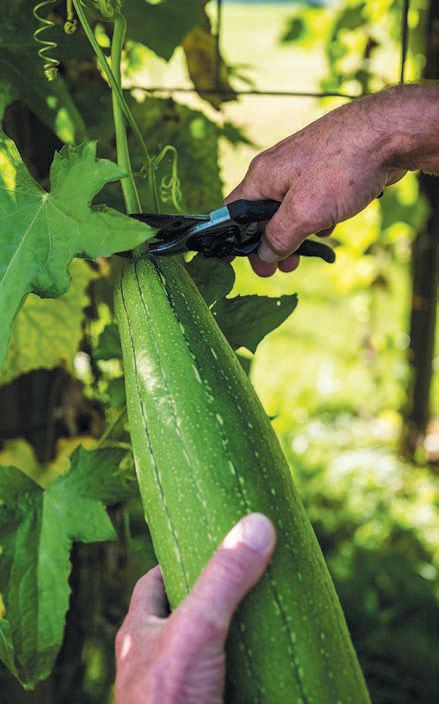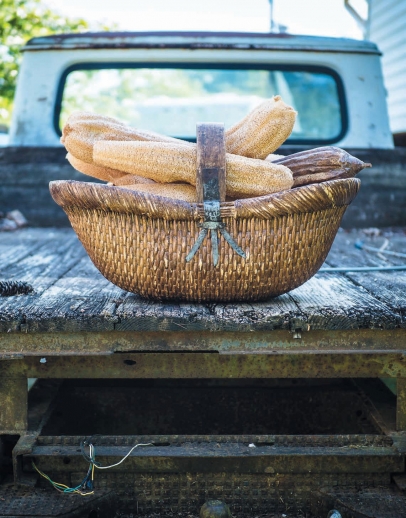FROM VINE TO BATH
How a farm in Bloomington harvests squash to create one-of-a-kind loofahs
Did you know a loofah is actually a vegetable? Although perhaps best known as a spongey scrubber used in the shower, in fact it’s an all-natural substance made from a squash. Yes, you can scrub with it—but you could also eat it.
Even more interesting, hundreds of loofahs are being grown and sold at market in Central Indiana.
David and Cheryl Lehman, owners of Earth Drops Natural Handcrafted Handmade Soap Company in Bloomington, were not looking to go into the business of producing loofah bath sponges. But the scrubbers have become a staple they now sell with their signature handmade soaps.
“Most people don’t believe the loofah is actually a squash,” says David. “When people see us selling them, they are always skeptical because they’ve never seen anything like it. Especially because they’re not a typical Indiana crop.”
The squash plant looks like a zucchini and grows on a trellis. They grow in abundance in warmer climates close to the equator—Brazil, Asia and Africa— where they are grown and harvested as a food crop. Loofahs are similar to zucchini in texture, but they taste more like an eggplant or mushroom.
In Indiana, loofah growth slows down in mid to late September when the evening temperatures drop below 45°. At that point, the squash is no longer viable for eating and it starts to look and feel better suited for scrubbing. Growing Loofah
The Lehmans started growing loofahs about 20 years ago when a friend (and member of a local gourd society) gave them loofah seeds and suggested they sell the plant-turned-sponge with their handmade soaps.
The growing process begins around March 1. David buffs the hard seeds with a metal file or sandpaper to soften them so they will open and germinate. He then plants them in individual peat pots and starts the growth indoors.
Once the evening temperatures warm above 45°—typically mid-May— the vines are about two feet long and they’re ready to be planted outside. Loofahs grow best on a fence or trellis they can climb. They then produce a flower blossom and grow into long, zucchini-looking squash, at which point they’re edible (only for about three to four weeks).
After that short timeframe, the loofah starts showing ribs on the outside skin, which is the indicator they are becoming a fibrous sponge. Typically by Did you know a loofah is actually a vegetable? Although perhaps best known as a spongey scrubber used in the shower, in fact it’s an all-natural substance made from a squash. Yes, you can scrub with it—but you could also eat it.
Even more interesting, hundreds of loofahs are being grown and sold at market in Central Indiana.
 Cheryl and David Lehman, owners of Earthdrops Natural Handcrafted Homemade Soap Company in Bloomington, produce loofah sponges as part of their product line. They also create pet-friendly soap for their Great Dane, Storm, pictured above.
Cheryl and David Lehman, owners of Earthdrops Natural Handcrafted Homemade Soap Company in Bloomington, produce loofah sponges as part of their product line. They also create pet-friendly soap for their Great Dane, Storm, pictured above.

The Merriam- Webster Dictionary defines “loofah” as “any of a genus (Luffa) of Old World tropical plants of the gourd family with white to yellow flowers and large usually elongate fruits that are sometimes eaten as vegetables when immature” or “a sponge consisting of the fibrous interior of the mature dried fruit of a loofah (especially Luffa aegyptiaca synonym L. cylindrica)— called also vegetable sponge.”
David and Cheryl Lehman, owners of Earth Drops Natural Handcrafted Handmade Soap Company in Bloomington, were not looking to go into the business of producing loofah bath sponges. But the scrubbers have become a staple they now sell with their signature handmade soaps.
“Most people don’t believe the loofah is actually a squash,” says David.
“When people see us selling them, they are always skeptical because they’ve never seen anything like it. Especially because they’re not a typical Indiana crop.”
The squash plant looks like a zucchini and grows on a trellis. They grow in abundance in warmer climates close to the equator—Brazil, Asia and Africa— where they are grown and harvested as a food crop. Loofahs are similar to zucchini in texture, but they taste more like an eggplant or mushroom.
In Indiana, loofah growth slows down in mid to late September when the evening temperatures drop below 45°. At that point, the squash is no longer viable for eating and it starts to look and feel better suited for scrubbing. Growing Loofah
The Lehmans started growing loofahs about 20 years ago when a friend (and member of a local gourd society) gave them loofah seeds and suggested they sell the plant-turned-sponge with their handmade soaps.
 The drying process begins when the loofah squash is still on the vine. After harvest, Cheryl cuts off the top of the squash and shakes out the seeds. Then she soaks the loofah, removes its skin and hangs it to dry until it’s ready to be used as a sponge.
The drying process begins when the loofah squash is still on the vine. After harvest, Cheryl cuts off the top of the squash and shakes out the seeds. Then she soaks the loofah, removes its skin and hangs it to dry until it’s ready to be used as a sponge.
The growing process begins around March 1. David buffs the hard seeds with a metal file or sandpaper to soften them so they will open and germinate. He then plants them in individual peat pots and starts the growth indoors.
Once the evening temperatures warm above 45°—typically mid-May— the vines are about two feet long and they’re ready to be planted outside. Loofahs grow best on a fence or trellis they can climb. They then produce a flower blossom and grow into long, zucchini-looking squash, at which point they’re edible (only for about three to four weeks).
After that short timeframe, the loofah starts showing ribs on the outside skin, which is the indicator they are becoming a fibrous sponge. Typically by late September, the squashes begin drying out and turning brown. They remain on the vines until the Lehmans harvest them in late December and early January. Cheryl then begins the process of cleaning the squash: She cuts off the stems and removes the seeds, then soaks the plant in warm water to loosen the skin. The skin is then removed, leaving the fibrous loofah that can be used as a sponge.
Earth Drops typically grows 200 to 300 loofahs in one season. They sell them for as much as $10 each. As far as they know, Earth Drops is the only loofah grower in Indiana.
Earth Drops also sells 25 varieties of soap. Each is 100% vegetable food grade using saponified oils of olive, coconut, rice bran and soybean along with other natural ingredients that include avocado, grapeseed, castor oils, pure essential oils, nuts, herbs, pure natural honey and milk.
Earth Drops also offers all-natural handmade soap for dogs. Cheryl created a pet-friendly recipe when their Great Dane, Storm, was suffering from skin issues. They say they spent thousands of dollars on allergy shots, steroids and shampoo, none of which helped Storm. Her hand-crafted Petables soaps and shampoos were the only thing that brought Storm relief.
While the Lehmans are now approaching their retirement years, they have no plans to slow down with Earth Drops and growing loofahs. Interacting with people and sharing their homegrown Indiana products with the country keeps them motivated.
“We enjoy it and love getting out and meeting people,” says David. “And it’s always neat to see people’s reaction when they learn the loofah is actually a squash.”
The Lehmans sell their loofahs and soaps at nearly 30 storefront locations across Indiana, as well as festivals in Indiana, Ohio and Kentucky. In the summer they travel to Colorado, where they sell at festivals in Woodland Park, Ridgeway and Gunnison. Soap is also available for purchase online. Each four-ounce bar sells for $3.74.
Earth Drops Natural Handcrafted Handmade Soap Company | 812.336.2491 | EarthDrops.com Visit the Indiana Gourd Society for more information at IndianaGourdSociety.org
Go to EdibleIndy.com to watch our Edible Indy Minute video about the loofah process created by Erik Cosar.





